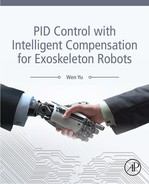Preface
Proportional-integral-derivative (PID) control is widely used in robot control systems. In the absence of robot knowledge, a PID controller may be the best controller, because it is model-free, and its parameters can be adjusted easily and separately. The PID controller has big advantages over the other controllers: simple and clear physical meaning. The three gains of the PID controller need to be tuned to guarantee good performances, which include rise-time, overshoot, settling time, and steady-state error. The integrator in the PID controller reduces the bandwidth of the closed-loop system. In order to remove the steady-state error caused by uncertainties and noise, the integrator gain has to be increased. This leads to worse transient performance, and even destroys the stability. Therefore many robot manipulators use pure proportional-derivative (PD) control or PD control with a small integral gain.
Model-based compensation for PD control is an alternative method for introducing an integral component to PD control, i.e., PID control. However, it needs the structure information of the robot. The controller becomes complex, and many good properties of the linear PD and PID control do not exist. Intelligent compensations for PD and PID control do not need a mathematical model; they are model-free compensators.
There are three different approaches to combine PID control with intelligent techniques: 1) The intelligent controllers are formed into the PID structure. By proper updating laws, the parameters of PID controllers are changed such that the closed-loop systems are stable. They are not real industrial PID controllers; 2) Intelligent techniques, such as fuzzy logic, neural networks, and the expert system, are used to tune the parameters of PID controllers; 3) The industrial linear PID controller adds an intelligent compensator. The main obstacle of this PID control with intelligent compensation is theoretically difficult in the performance analysis. Even for linear PID, it is not easy to prove asymptotic stability. Without a theoretical guarantee for this PID control, industrial applications cannot be carried out safely. This book is intended for the third one.
Throughout the last three decades, many designs of exoskeletons for human power amplification have been developed and evaluated. In 2000 the author took his sabbatical year in Professor Jacob Rosen's bionics lab, University of California at Santa Cruz. The author started his research on the control problems of the exoskeleton robots. From 2012 to 2016, the author was supported by the CONACyT's project “Intelligent Human–Robot Interaction and Robotic Rehabilitation Exoskeleton,” and started to study stable PID control for exoskeleton robots. After five years of work, the results on closed-loop tuning of PID parameters, stability analysis of PD and PID control with intelligent compensations, PID control in task space, PID admittance control, and trajectory generation of the exoskeleton robot, are developed. These results have been published in a variety of journals and conferences. The author wishes to put together all these results within this book.
Much of the material in this book was presented in the author's two courses in CINVESTA-IPN: Medical Robotics and the Introduction to Robotics. Part of the book was written while the author was visiting the University of California at Santa Cruz. This book is organized as a textbook for the course on the control of robots. It could be used for self-learning. The level of competence expected for the reader is that they have covered courses in robotics, nonlinear systems analysis, neural networks, and some elements of the optimization theory.
Many people have contributed to shape and substance of this book. The author would like to thank Professor Jacob Rosen, Dr. Ji Ma, Dr. Levi Miller, his former PhD, and master students Debbie Crystal Hernández, Carlos Parga Ingenieur, Edgar Oswaldo García, José Adolfo Perrusquía, and Javier Garrido Melendez. In addition, he would like to thank Dr. Alberto Soria López and Dr. Rubén Alejandro Garrido for helping to develop the exoskeleton robots. The author want to thank the financial supports of CONACyT, Mexico, with the projects 167428, 50480Y, and the University of California – CONACyT 2012. Last, but not least, the author is thankful for the time and dedication of his wife, Xiaoou. Without her, this book would not be possible.
Mexico, May of 2017
